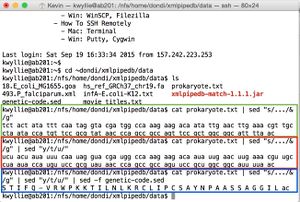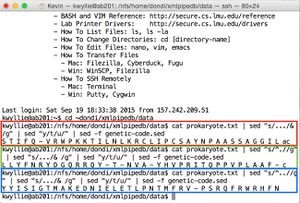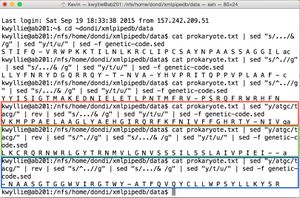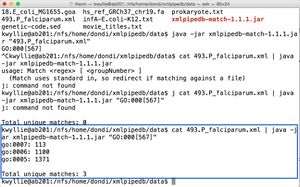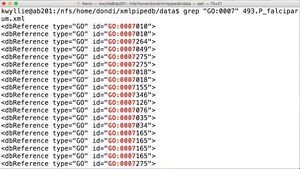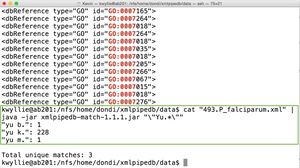Difference between revisions of "Kevin Wyllie Week 3"
From LMU BioDB 2015
(Just saving my progress in case of a connection timeout.) |
(Saving my progress. Will finish soon.) |
||
| Line 86: | Line 86: | ||
[[Image:Kwscreenshot5.jpg|right|thumb]] | [[Image:Kwscreenshot5.jpg|right|thumb]] | ||
| − | * To count the occurrence of GO:0005, GO:0006, and GO:0007 (shown on right): | + | * '''To count the occurrence of GO:0005, GO:0006, and GO:0007 (shown on right):''' |
cat 493.P_falciparum.xml | java -jar xmlpipedb-match-1.1.1.jar "GO:000[567]" | cat 493.P_falciparum.xml | java -jar xmlpipedb-match-1.1.1.jar "GO:000[567]" | ||
* There are three unique matches (the maximum possible for this command). | * There are three unique matches (the maximum possible for this command). | ||
| Line 92: | Line 92: | ||
** GO:0006 occurred 1,100 times. | ** GO:0006 occurred 1,100 times. | ||
** GO:0007 occurred 113 times. | ** GO:0007 occurred 113 times. | ||
| + | |||
[[Image:Kwscreenshot6.jpg|right|thumb]] | [[Image:Kwscreenshot6.jpg|right|thumb]] | ||
| − | * To find | + | * '''To find GO:0007 "in situ" (shown on right):''' |
grep "GO:0007" 493.P_falciparum.xml | grep "GO:0007" 493.P_falciparum.xml | ||
* Looking at the text found on the same lines as this pattern, it appears to be the first few characters of a gene ID. Based on prior knowledge, it also may have something to do with gene ontology, as I have seen "GO" as an acronym for that term before. | * Looking at the text found on the same lines as this pattern, it appears to be the first few characters of a gene ID. Based on prior knowledge, it also may have something to do with gene ontology, as I have seen "GO" as an acronym for that term before. | ||
| Line 102: | Line 103: | ||
[[Image:Kwscreenshot7.jpg|right|thumb]] | [[Image:Kwscreenshot7.jpg|right|thumb]] | ||
| − | * To count the occurrence of \"Yu.*\" (shown on right): | + | * '''To count the occurrence of \"Yu.*\" (shown on right):''' |
cat "493.P_falciparum.xml" | java -jar xmlpipedb-match-1.1.1.jar "\"Yu.*\"" | cat "493.P_falciparum.xml" | java -jar xmlpipedb-match-1.1.1.jar "\"Yu.*\"" | ||
* There are three unique matches. | * There are three unique matches. | ||
| − | ** | + | ** "yu b." occurred one time. |
| + | ** "yu k." occurred 228 times. | ||
| + | ** "yu m." occurred one time. | ||
| + | * A grep command for this pattern brings up lines such as: | ||
| + | <person name="Yu K."/> | ||
| + | So these may be names of biologists, perhaps those who were responsible for the discovery of a given gene. | ||
Revision as of 18:29, 20 September 2015
Contents
Complement of a Strand
- Shown in green: the following command is used to open the file (using prokaryote.txt as an example).
cat prokaryote.txt
- Shown in red: the following command is used to sequence the complementary strand (in the 5' -> 3' direction - thus the "rev" command).
cat prokaryote.txt | sed "y/atgc/tacg/" | rev
- These commands yield the nucleotide sequence:
- 5'- gttaaaatgccgccagcggaactggcggctgggttatacgcggaacatggtattaggcaacgtttcaagttcaatattgtcttctttggccatcgtacctattgaaatatagtaga -3'
Reading Frames
The original sequence in the prokaryote.txt file will be assumed to be the top strand for this exercise.
+1, +2, and +3 Frames
- Shown in green: to separate the strand into codons (resulting in the +1 frame):
cat prokaryote.txt | sed "s/.../& /g"
- Shown in red: to convert to the mRNA sequence (treating the DNA stand as the mRNA-like strand):
cat prokaryote.txt | sed "s/.../& /g" | sed "y/t/u/"
- Shown in blue: to translate this mRNA sequence (yielding the +1 frame):
cat prokaryote.txt | sed "s/.../& /g" | sed "y/t/u/" | sed -f genetic-code.sed
- For the +2 frame, the final pipe can be slightly altered:
cat prokaryote.txt | sed "s/^.//g" | sed "s/.../& /g" | sed "y/t/u/" | sed -f genetic-code.sed
- And similarly, for the +3 frame:
cat prokaryote.txt | sed "s/^..//g" | sed "s/.../& /g" | sed "y/t/u/" | sed -f genetic-code.sed
- These pipes yield the following amino acid sequences (shown on right):
- +1 Nter- S T I F Q -Cter (shown in green)
- +2 Nter- L L Y F N R Y D G Q R R Q Y -Cter (shown in red)
- +3 Nter- Y Y I S I G T M A K E D N I E L E T L P N T M F R V -Cter (shown in blue)
-1, -2, and -3 Frames
- For the -1 frame, open the file as usual, and then use the pipe from "Complement of a Strand" so that the commands after it will be applied to the complementary strand (instead of the original strand). Then, add the same pipe used for the +1 strand:
cat prokaryote.txt | sed "y/atgc/tacg/" | rev | sed "s/.../& /g" | sed "y/t/u/" | sed -f genetic-code.sed
- As before, the -2 and -3 frames can be found by making a single adjustment to the pipe for the -1 frame. For the -2 frame:
cat prokaryote.txt | sed "y/atgc/tacg/" | rev | sed "s/^.//g" | sed "s/.../& /g" | sed "y/t/u/" | sed -f genetic-code.sed
- And for the -3 frame:
cat prokaryote.txt | sed "y/atgc/tacg/" | rev | sed "s/^..//g" | sed "s/.../& /g" | sed "y/t/u/" | sed -f genetic-code.sed
- These pipes yield the following amino acid sequences (shown on right):
- -1 Nter- V K M P P A E L A A G L Y A E H G I R Q R F K F N I V F F G H R T Y -Cter (shown in green)
- -2 Nter- L K C R Q R N W R L G Y T R N M V L G N V S S S I L S S L A I V P I E I -Cter (shown in red)
- -3 No polypeptide - first codon is STOP. (shown in blue)
XMLPipeDB Match Practice
- To count the occurrence of GO:0005, GO:0006, and GO:0007 (shown on right):
cat 493.P_falciparum.xml | java -jar xmlpipedb-match-1.1.1.jar "GO:000[567]"
- There are three unique matches (the maximum possible for this command).
- GO:0005 occurred 1,371 times. GO:0007 occurred 113 times.
- GO:0006 occurred 1,100 times.
- GO:0007 occurred 113 times.
- To find GO:0007 "in situ" (shown on right):
grep "GO:0007" 493.P_falciparum.xml
- Looking at the text found on the same lines as this pattern, it appears to be the first few characters of a gene ID. Based on prior knowledge, it also may have something to do with gene ontology, as I have seen "GO" as an acronym for that term before.
- To count the occurrence of \"Yu.*\" (shown on right):
cat "493.P_falciparum.xml" | java -jar xmlpipedb-match-1.1.1.jar "\"Yu.*\""
- There are three unique matches.
- "yu b." occurred one time.
- "yu k." occurred 228 times.
- "yu m." occurred one time.
- A grep command for this pattern brings up lines such as:
<person name="Yu K."/>
So these may be names of biologists, perhaps those who were responsible for the discovery of a given gene.

